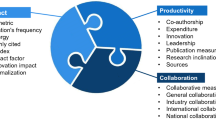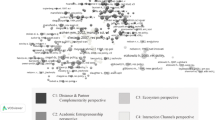Abstract
The present study proposes a bibliometric methodology for measuring the grade of correspondence between regional industry’s demand for research collaboration and supply from public laboratories. The methodology also permits measurement of the intensity and direction of the regional flows of knowledge in public–private collaborations. The aim is to provide a diagnostic instrument for regional and national policy makers, which could add to existing ones to plan interventions for re-balancing sectorial public supply of knowledge with industrial absorptive capacity, and maximizing appropriability of knowledge spillovers. The methodology is applied to university–industry collaborations in the hard sciences in all Italian administrative regions.

Similar content being viewed by others
Notes
It should be noted that in addition to universities, research institutes also contribute to the production of new knowledge, but are not fully considered in this work. The current work is primarily intended to describe a measurement system and provide an example of its application to the Italian case: the results should be interpreted in this sense.
Legislation in 2001 introduced the so called “academic privilege”, presumably resulting in additional patents filed by university researchers, but relevant data are not readily available, making the identification of joint patents very difficult.
Civil Engineering was not considered because the relevant publications are poorly represented in the SCI™.
For further information see Abramo et al., 2011.
A number of publications evidently are co-authored by more than one university/company, and by researchers from different SDSs.
From Azagra-Caro (2007): “We follow Cohen and Levinthal’s (1990) definition of absorptive capacity: ‘‘a limit to the rate or quantity of scientific or technological information that a firm can absorb’’. To justify the extension of the concept of absorptive capacity from firms to regions see Niosi and Bellon (2002)”.
The assumption can easily be modified to adapt the analysis to the characteristics of different SDSs, or in light of the personnel resources that universities might assign to respond to industrial demand for collaboration.
This interpretation is not intended as a superficial suggestion that universities should resize their research capacity in the SDS examined. Capacity must also be planned in relation to the other two primary roles of the university: higher education and research.
However, over time, there have been significant delegations of central authority to the regions (Title V of the constitution), and these are tending to increase, resulting in a current gradual development of regional federalism. For example, the regions have recently obtained the power to enact incentive measures for research in specific sectors, with appropriately targeted financing.
See Abramo et al. (2008) for further information on potential distortions in aggregate bibliometric analyses that do not consider sectorial specificity.
References
Abramo, G., D’Angelo, C. A., & Di Costa, F. (2008). Assessment of sectorial aggregation distortion in research productivity measurements. Research Evaluation, 17(2), 111–121.
Abramo, G., D’Angelo, C. A., Di Costa, F., & Solazzi, M. (2011). The role of information asymmetry in the market for university–industry research collaboration. The Journal of Technology Transfer, 36(1), 84–100.
Abramo, G., & Pugini, F. (2005). L’attività di licensing delle università italiane: un’indagine empirica. Economia e Politica Industriale XXXII, 3, 43–60.
Acs, Z. J., Anselin, L., & Varga, A. (2002). Patents and innovation counts as measures of regional production of new knowledge. Research Policy, 31, 1069–1085.
Anselin, L. (1998). Spatial econometrics: Methods and models. Dordrecht: Kluwer.
Anselin, L., Varga, A., & Acs, Z. J. (1997). Local geographic spillovers between university research and high technology innovations. Journal of Urban Economics, 42, 422–448.
Anselin, L., Varga, A., & Acs, Z. J. (2000). Geographic and sectoral characteristics of academic knowledge externalities. Papers in Regional Science, 79, 435–443.
Arundel, A., & Geuna, A. (2004). Proximity and use of public science by innovative European firms. Economics of Innovation and New Technology, 13(6), 559–580.
Audretsch, D. B., & Feldman, M. P. (1996). R&D spillovers and the geography of innovation and production. American Economic Review, 86(3), 630–640.
Audretsch, D. B., & Keilbach, M. (2004). Entrepreneurship and regional growth: an evolutionary interpretation. Journal of Evolutionary Economics, 14, 605–616.
Audretsch, D. B., & Lehmann, E. E. (2005). Does the knowledge spillover theory of entrepreneurship hold for regions? Research Policy, 34, 1191–1202.
Autant-Bernard, C. (2001). Science and knowledge flows: Evidence from the French case. Research Policy, 30(7), 1069–1078.
Azagra-Caro, J. M. (2007). What type of faculty member interacts with what type of firm? Some reasons for the delocalisation of university–industry interaction. Technovation, 27, 704–715.
Barca, F. (2009). An agenda for a reformed cohesion policy, Report to the EU. Accessed November 11, 2011, from http://ec.europa.eu/regional_policy/policy/future/pdf/report_barca_v0306.pdf.
Boschma, R. (2005). Proximity and innovation: A critical assessment. Regional Studies, 39(1), 61–74.
Boyack, K. W., Klavans, R., & Börner, K. (2005). Mapping the backbone of science. Scientometrics, 64(3), 351–374.
Breschi, S., & Lissoni, F. (2001). Knowledge spillovers and local innovation systems: A critical survey. Industrial and Corporate Change, 10(4), 975–1005.
Cineca (2008). Accessed November 11, 2011 http://cercauniversita.cineca.it/php5/docenti/cerca.php.
Cohen, W. M., & Levinthal, D. A. (1990). Absorptive capacity: A new perspective on learning and innovation. Administrative Science Quarterly, 35(1), 128–152.
D’Angelo, C. A., Abramo, G., & Giuffrida, C. (2011). A heuristic approach to author name disambiguation in large-scale bibliometric databases. Journal of the American Society for Information Science and Technology, 62(2), 257–269.
Etzkowitz, H., & Leydesdorff, L. (1998). The endless transition: A “triple helix” of university–industry–government relations. Minerva, 36, 203–208.
Feldman, M. P. (1994). The geography of innovation. Dordrecht: Kluwer.
Fingleton, B., & López-Bazo, E. (2006). Empirical growth models with spatial effects. Papers in Regional Science, 85(2), 171–198.
Gerstlberger, W. (2004). Regional innovation systems and sustainability-selected examples of international discussion. Technovation, 24, 749–758.
Greunz, L. (2003). Geographically and technologically mediated knowledge spillovers between European regions. The Annals of Regional Science, 37, 657–680.
Jaffe, A. B. (1989). Real effects of academic research. American Economic Review, 79(5), 957–970.
Jaffe, A. B., Henderson, R., & Trajtenberg, M. (1993). Geographic localization of knowledge spillovers as evidenced by patent citations. The Quarterly Journal of Economics, 108, 577–598.
Katz, J. S. (1994). Geographic proximity and scientific collaboration. Scientometrics, 31(1), 31–43.
Katz, J. S., & Martin, B. R. (1997). What is research collaboration? Research Policy, 26(1), 1–18.
Laudel, G. (2001). What do we measure by co-authorships? Proceedings of the 8th International Conference on Scientometrics and Informetrics, Sydney (pp. 369–384). Sydney: BIRG (UNSW).
LeSage, J. P., Fischer, M. M., & Scherngell, T. (2007). Knowledge spillovers across Europe: Evidence from a poisson spatial interaction model with spatial effects. Papers in Regional Science, 86(3), 393–421.
Leydesdorff, L., & Rafols, I. (2009). A global map of science based on the ISI subject categories. Journal of the American Society for Information Science and Technology, 60(2), 348–362.
Maggioni, M.A., Uberti, T.E. (2005) Knowledge flows and regional disparities in Europe: Geographic, functional and sectoral distance. Paper prepared for the Conference on Agglomeration Economies and Regional Growth, Cagliari (pp. 20–21). Cagliari: University of Cagliari.
McCann, P., Ortega-Argilés, R. (2011). Smart specialisation, regional growth and applications to EU, Working paper. Accessed November 11, 2011, from http://www.rug.nl/staff/p.mccann/McCannSmartSpecialisationAndEUCohesionPolicy.pdf.
Melin, G., & Persson, O. (1996). Studying research collaboration using co-authorships. Scientometrics, 36(3), 363–367.
Metcalfe, J. S. (2002). Knowledge of growth and the growth of knowledge. Journal of Evolutionary Economics, 12, 3–15.
Moreno, R., Paci, R., & Usai, S. (2005). Spatial spillovers and innovation activity in European regions. Environment and Planning A, 37(10), 1793–1812.
Mueller, P. (2006). Exploring the knowledge filter: How entrepreneurship and university–industry relationships drive economic growth. Research Policy, 35, 1499–1508.
Niosi, J., Bellon, B. (2002). The absorptive capacity of regions, Colloque Economie Mediterranee Monde Arabe, Sousse, 20–21 September.
Noyons, E. C. M., & Calero-Medina, C. (2009). Applying bibliometric mapping in a high level science policy context. Scientometrics, 79(2), 261–275.
OECD, (2007). OECD Science, Technology and Industry Scoreboard 2007, ISBN 978-92-64-03788-5.
Parente, R., Petrone, M. (2006). Distretti tecnologici ed efficacia delle strategie pubbliche nella mobilitazione del venture capital, Conference AIDEA 06—Finanza e Industria in Italia, Roma, 28/29 settembre 2006.
Polanyi, M. (1985). Implicit knowledge, Frankfurt/Main.
Rodrìguez-Pose, A., & Crescenzi, R. (2008). Research and development, spillovers, innovation systems, and the genesis of regional growth in Europe. Regional Studies, 42(1), 51–67.
Rondé, P., & Hussler, C. (2005). Innovation in regions: What does really matter? Research Policy, 34, 1150–1172.
van Eck, N. J., & Waltman, L. (2010). Software survey: VOSviewer, a computer program for bibliometric mapping. Scientometrics, 84(2), 523–538.
Van Looy, B., Debackere, K., & Andries, P. (2003). Policies to stimulate regional innovation capabilities via university–industry collaboration: An analysis and an assessment. R&D Management, 33(2), 209–229.
Varga, A., & Schalk, J. (2004). Knowledge spillovers, agglomeration and macroeconomic growth: An empirical approach. Regional Studies, 38, 977–989.
Waltman, L., van Eck, N. J., & Noyons, E. C. M. (2010). A unified approach to mapping and clustering of bibliometric networks. Journal of Informetrics, 4(4), 629–635.
Acknowledgments
The authors express their sincere thanks to Flavia Di Costa, for her invaluable contribution to the data analysis. Any possible inaccuracies or other errors remain as the complete responsibility of the authors.
Author information
Authors and Affiliations
Corresponding author
Rights and permissions
About this article
Cite this article
Abramo, G., D’Angelo, C.A. & Solazzi, M. A bibliometric tool to assess the regional dimension of university–industry research collaborations. Scientometrics 91, 955–975 (2012). https://doi.org/10.1007/s11192-011-0577-5
Received:
Published:
Issue Date:
DOI: https://doi.org/10.1007/s11192-011-0577-5




